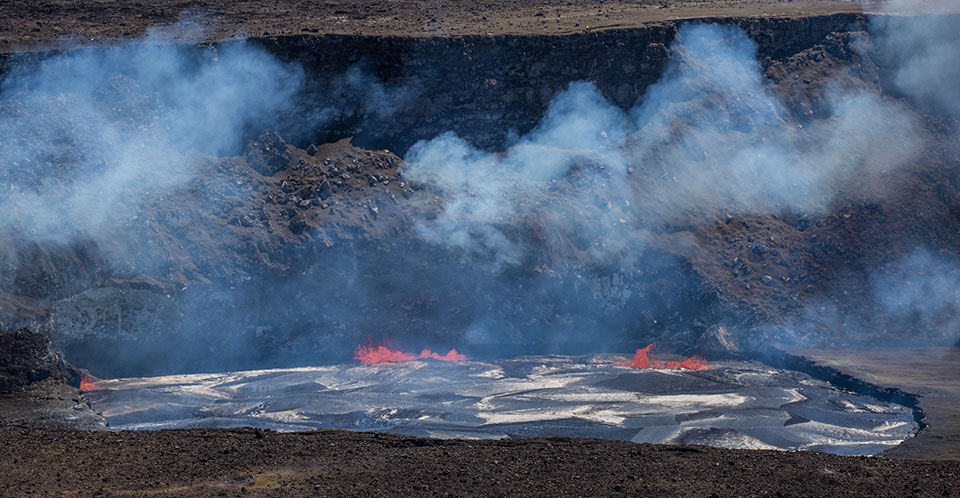9th Anniversary of Kīlauea’s Halemaʻumaʻu Crater Eruption

Sunset view of the Kīlauea summit lava lake showing an active area of spattering at the right margin. Jagged openings between cooler crustal plates reveal molten lava. HVO is faintly visible on the Kīlauea Caldera rim at upper left. USGS photo Feb. 13, 2017.
Kīlauea Volcano’s summit eruption in Halemaʻumaʻu Crater began in March 2008.
Since that time, countless changes have occurred. The crater enclosing the lava lake (called the Overlook crater) has enlarged through rockfalls, and explosions have thrown spatter around the crater and onto the rim of Halemaʻumaʻu itself. The lava-lake level has fluctuated, leading to several overflows of lava onto the Halemaʻumaʻu Crater floor.
The past year has been a notable one for a simple reason: the lake is now frequently visible from public viewing areas. For most of the eruption, the lake has been too far beneath the crater rim to be seen, and only glow was visible from afar. Lava levels rose sharply at the start of 2016, with the lake poised just out of view for the first half of that year.
During the second half 2016, another rise finally brought the lake high enough that it has been commonly visible from Jaggar Overlook inside Hawai‘i Volcanoes National Park. The sight of the lake is often incredible, particularly at dawn and dusk, with clear views of the slowly shifting crustal plates and large gas bubbles bursting at spattering areas on the lake margin.
The lake today is also quite large compared with its modest beginning and compared with other lava lakes around the world. The surface area of the lake has been slowly growing since 2008 and in 2016 it increased about 20%. The lake now covers about 10 acres.
Only a half-dozen or so persistent lava lakes exist on Earth, including those at Erebus Volcano (Antarctica), Erta Ale Volcano (Ethiopia), Nyiragongo Volcano (Democratic Republic of the Congo) and Ambrym Volcano (Vanuatu).
Of these, only Nyiragongo has dimensions comparable to Halemaʻumaʻu. Nyiragongo’s lake has been measured between 9 and 12 acres over the past decade. The other lakes are all under 1 acre. Halemaʻumaʻu and Nyiragongo are, by a wide margin, the two largest lava lakes on Earth.
The high lava level is not only good for viewing opportunities, but it also facilitates better scientific studies of the lake. Hawaiian Volcano Observatory scientists and their collaborators have recently completed a number of studies that provide unprecedented insights into lava lake behavior.
For instance, we now know that the lava lake in Halemaʻumaʻu provides a “window” into the deeper magma system in some respects, but at the same time, the lake has its own internal dynamics that are superimposed on these deeper signals.
Despite the lake providing a beautiful view and a unique opportunity for scientific study, the lake comes with one major drawback: vog. All of that spattering in the lake releases large amounts of gas, which has to go somewhere. Most often, the gas plume is carried southwest in the trade winds, impacting air quality in the Ka‘ū District and Kona-side of the island. When trade winds break down, other areas of the Island of Hawai‘i and even the entire state can be impacted by vog. More information on vog can be found online.

Telephoto view of Halemaʻumaʻu from Hawai‘i Volcanoes National Park’s Jaggar Overlook on Oct. 15, 2016. NPS photo by J. Wei.
Could the lake rise even higher? It’s possible that a slight increase in magma reservoir pressure—possibly from an increase in magma supply from the mantle source—could push the lake level higher leading to further overflows onto the Halemaʻumaʻu Crater floor. If higher levels and overflows are sustained, they would likely lead to the development of a “perched” lava lake—that is, a lava lake contained within steep levees of solidified lava.
What is the overall outlook for the summit eruption? Although the lake has slowly risen over the past year and the summit has slowly inflated in concert, the majority of monitoring indicators at Halemaʻumaʻu have been relatively steady. Right now, there are no signs of the eruption slowing down.
Halemaʻumaʻu Crater has a long history of lava lake activity, including decades of sustained lava lakes in the 1800s and early 1900s. This record demonstrates that the current eruption has the potential to last for many years. As we approach a decade of continuous lava lake activity, it becomes easier to imagine that the lava lake could be here for quite a while.
Volcano Watch is a weekly article written by U.S. Geological Survey Hawaiian Volcano Observatory scientists and affiliates.
Call for summary updates at (808) 967-8862 (Kīlauea) or (808) 967-8866 (Mauna Loa); email questions to askHVO@usgs.gov.






